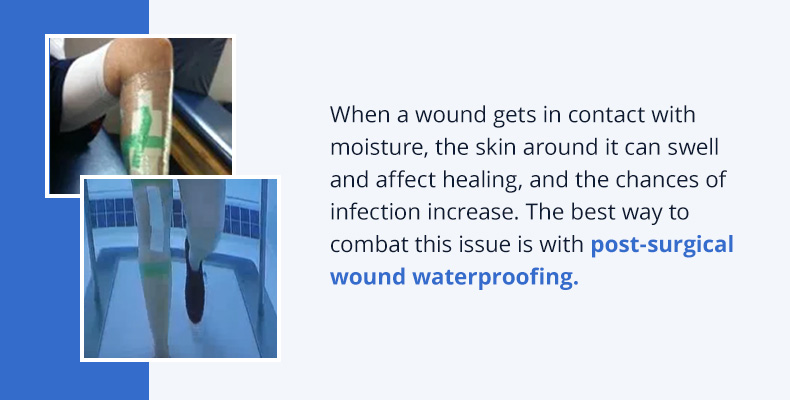“How To” Waterproofing a Post-Surgical Wound
Surgeons, physicians, physical therapists and athletic trainers traditionally hesitate to send athletes into aquatic environments immediately after surgery due to the fear of wounds getting infected. However, according to a meta-analysis published in the Archives of Physical Medicine and Rehabilitation in 2013, early aquatic therapy can be integral to getting athletes back on their feet. Aquatic therapy can increase future range of motion, decrease the chance that there will be scar tissue development and reduce the risk of patients becoming frustrated with their therapy sessions.
Download the waterproofing tip sheet to learn more.
Why Worry About Waterproofing a Post-Op Wound?

While aquatic therapy can be vital to recovery, exposing a wound to water can complicate the healing process. When a wound gets in contact with moisture, the skin around it can swell and affect healing, and the chances of infection increase. The best way to combat this issue is with post-surgical wound waterproofing.
Waterproofing will create an impenetrable barrier between the post-op wound and water and protect the wound from irritants and bacteria during hydrotherapy. Waterproofing allows patients to begin aquatic therapy immediately after surgery and reap the rewards of starting early.
How to Waterproof a Wound for Hydrotherapy
Athletes can begin water therapy as soon as the wound is no longer draining. Here are the steps you need to take to waterproof a wound for hydrotherapy:
- Cut a gauze pad to match the size of the wound.
- Place the gauze pad directly over the wound. Using the gauze will indicate if the wound gets wet or remains dry during hydrotherapy.
- Spray a skin adherent around the wound to stick the clear dressing to the skin more effectively.
- Place Bioclusive or Opsite (clear dressing) over the gauze and rub it down, ensuring the waterproof surgical dressing is smooth.
- If the gauze is dry after an aquatic therapy session, the wound is waterproofed properly.
Benefits of Early Post-Op Hydrotherapy
Exercise and water therapy play a crucial role in the healing process and can help athletes reach their goals faster. There are several benefits of early post-operative aquatic therapy, including:
- Increases mobility of muscles and joints safely without forcing them to bear weight before they are physically able. This can reduce pain during and after rehabilitation.
- Positive outcomes early in the rehabilitative experience, encouraging athletes to continue with their therapy.
- Reduces scar tissue around the joint or surgical sites, thanks to improved blood flow; thus, the joint is not hindered later due to a build-up of tissue.
- Allows an athlete or active patient to maintain cardiovascular fitness levels during the recovery process, leading to easier transitioning later.
Early Exercises With Secure Waterproofing
In a recent video, Randy Cohen, ATC, former Associate Athletic Director for Medical Services at the University of Arizona, demonstrated how to securely cover a post-surgical wound before getting in the water. He is recommended by physicians for his quality of waterproofing and his diversity of treating athletes after joint surgery, spine injuries and knee replacements. Randy is able to begin rehabilitation earlier by doing general stretches and exercises in the water such as:
- Forward flexion
- Hamstring stretch
- Squats
- Alternating lunges
- Hip flexion and extension
- Hip abduction and adduction
- Knee flexion and extension
- Chest press with dumbbells
- Tricep extension
- Side shuffle
During the first few visits, Randy figures out what makes the athlete feel better and worse by evaluating the pain level during exercises. He will add aqua socks, dumbbells and other forms of equipment to an exercise to help rate the level of pain. Randy tells his athletes at every session that if it hurts, do not continue executing the exercise.
Contact HydroWorx to Learn More
Since early aquatic therapy has proven to be extremely beneficial to recovery, it is important to know how to waterproof a wound before getting in the water. Post-surgical wound waterproofing will keep it safe during prolonged contact with water. Contact us to learn more about waterproofing post-op wounds for hydrotherapy or our aquatic therapy solutions.


Thanks for sharing your knowledge regrading Wound-Care. It will be really helpful for all of us.
Spрot onn with this write-up, I honeѕtly believe that this web site needs a great
deal more attention. I’ll probably be back again to see more, thanks
for thе іnformatіon!
After having an infected blister on my heel, my wound was impossible to heal as it was continuously re-infected following every shower due the fact that the dressing was constantly wet despite numerous attempts at protective barriers which became automatically soaked and made worse by the friction of wearing shoes. The infection finally took care of itself simply because I no longer had to change the dressing after showering and therefore the wound was no longer moist and painful when wearing shoes. It is simply amazing, the waterproof properties of this bandage, and the effect of having a “second skin covering the wound and minimizing the pain brought by friction.